A market valuation of USD 1,452.4 million has been estimated for 2025 in the light-activated anti-pollution skincare industry, with the figure expected to rise to USD 4,902.6 million by 2035. This progression reflects an overall addition of USD 3,450.2 million, translating into a CAGR of 12.9% during the decade under review. The growth trajectory indicates a more than threefold expansion, underscoring the increasing role of light-activated systems in advanced skincare formulations.

Light-Activated Anti-Pollution Skincare Market Key Takeaways
| Metric | Value |
|---|---|
| Light-Activated Anti-Pollution Skincare Market Estimated Value in (2025E) | USD 1,452.4 million |
| Light-Activated Anti-Pollution Skincare Market Forecast Value in (2035F) | USD 4,902.6 million |
| Forecast CAGR (2025 to 2035) | 12.90% |
During the initial phase from 2025 to 2030, the market is projected to climb from USD 1,452.4 million to USD 2,668.4 million, an addition of USD 1,216 million, which accounts for approximately 35% of the total growth expected over the decade. This stage is likely to be characterized by rapid adoption of SPF-included anti-pollution shields, which are forecasted to command a 52% share in 2025, valued at USD 588.9 million. Concurrently, moisturizers with SPF are anticipated to dominate the product landscape with a 55% share in 2025, translating into USD 566.7 million in sales.
In the subsequent period from 2030 to 2035, expansion is forecasted to accelerate, with the market increasing from USD 2,668.4 million to USD 4,902.6 million. This gain of USD 2,234.2 million will represent 65% of total decade growth, driven by heightened consumer demand for blue-light and IR defense solutions, alongside stronger traction for encapsulation-based delivery technologies. By 2035, digital-driven awareness and e-commerce penetration are expected to consolidate the leadership of multifunctional, clinically validated skincare formulations in this market.
From 2020 to 2024, the market foundation was shaped by rising consumer awareness of urban pollution and digital light exposure. By 2025, demand for multifunctional skincare solutions is expected to anchor growth, with SPF-included and anti-pollution shield claims forecasted to dominate. During the decade ahead, the revenue base is projected to shift significantly, with e-commerce channels strengthening above 50% share and clean-label claims gaining momentum in high-growth regions such as China and India.
Competitive positioning is expected to evolve as differentiation moves from product efficacy alone to holistic strategies encompassing clinical validation, sustainability, and advanced encapsulation technologies. Established global brands are projected to face intensified competition from digital-first challengers and regionally specialized players, leading to a market in which innovation ecosystems and brand authenticity are set to determine long-term leadership.
Growth in the light-activated anti-pollution skincare market is being driven by heightened consumer awareness of environmental stressors, digital light exposure, and the rising demand for multifunctional skin defense solutions. Advancements in photoreactive systems, including photochromic polymer shields and encapsulation-based delivery, have been enabling more effective protection against pollutants, UV rays, and blue light. Increasing urbanization and digital lifestyle shifts are expected to accelerate adoption, as consumers seek products that address both outdoor and indoor aggressors.
E-commerce expansion is anticipated to enhance accessibility, particularly in emerging economies, while clean-label and dermatologist-tested claims are forecasted to reinforce consumer trust. Premiumization trends in East Asia and strong clinical positioning in North America are projected to further consolidate demand. With moisturizers with SPF and SPF-included functions already dominating early market adoption, momentum is expected to intensify as innovations in light-activated microcapsules and blue-light defense redefine performance standards. These dynamics are anticipated to sustain robust double-digit growth through 2035.
The light-activated anti-pollution skincare market has been segmented by claim, function, and product type, each reflecting distinct consumer priorities and innovation pathways. Claim-based segmentation is defined by the rising prominence of SPF-included formulations alongside alternatives such as dermatologist-tested and clean-label offerings. Function-based classification highlights the leading role of anti-pollution shield technologies while also recognizing the growing importance of blue-light and IR defense.
Product type segmentation illustrates how daily-use moisturizers with SPF continue to dominate consumer adoption, while other formats such as serums and essences are gaining traction. Together, these segments are expected to shape the competitive landscape and drive innovation throughout the forecast period, ensuring that both protective efficacy and consumer trust remain central to growth.
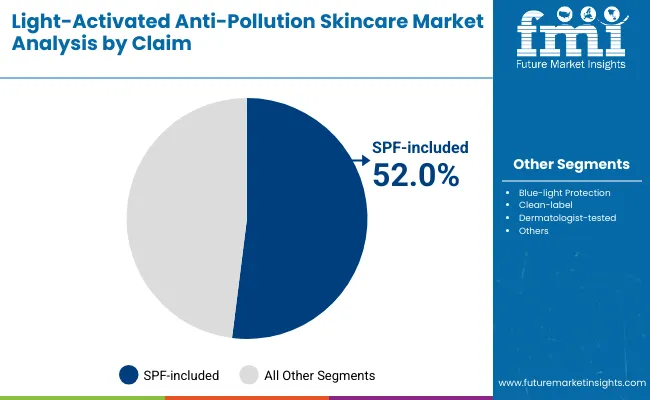
| Segment | Market Value Share, 2025 |
|---|---|
| SPF-included | 52% |
| Others | 48.0% |
SPF-included claims are projected to capture 52% share in 2025, valued at USD 588.9 million. The claim segment of the light-activated anti-pollution skincare market is expected to grow steadily, as consumer trust in multifunctional skincare solutions continues to increase. Adoption is anticipated to be reinforced by rising awareness of UV-induced damage combined with environmental aggressors. Other claims, representing 48% share and USD 697.15 million, are projected to perform strongly as demand for dermatologist-tested and clean-label positioning gains momentum. This balance between SPF-included and alternative claims is forecasted to create a diversified growth path over the decade.
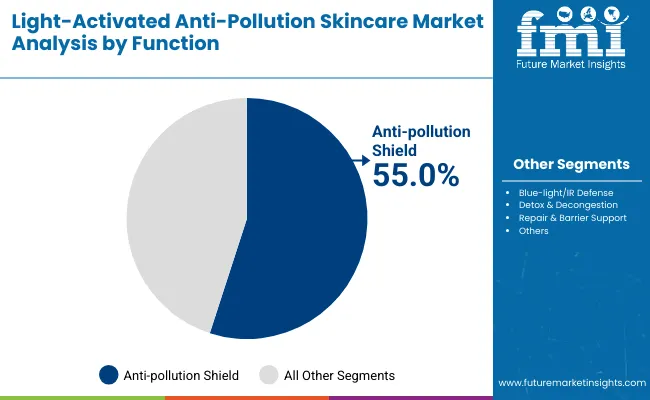
| Segment | Market Value Share, 2025 |
|---|---|
| Anti-pollution shield | 55% |
| Others | 45.0% |
Anti-pollution shield functions are forecasted to account for 55% share in 2025, valued at USD 566.7 million. The function segment is expected to expand rapidly as urbanization and pollution exposure continue to intensify, heightening consumer need for effective protective solutions. Adoption is projected to be strengthened by innovation in photoreactive complexes that deliver advanced environmental defense. Other functions, with a 45% share valued at USD 653.58 million, are forecasted to build traction as consumers increasingly recognize the impact of digital light and infrared exposure. The balance between these categories is anticipated to define the next phase of skincare innovation.

| Segment | Market Value Share, 2025 |
|---|---|
| Moisturizers with SPF | 49% |
| Others | 51.0% |
Moisturizers with SPF are projected to hold 49% share in 2025, valued at USD 533.3 million. The product type segment is forecasted to remain anchored by moisturizers, given their convenience of daily application and consumer confidence in clinically validated protection. Their adoption is expected to expand across both premium and mass-market categories, reinforcing leadership. Other product types, accounting for 51% share at USD 740.72 million, are projected to accelerate due to rising interest in lightweight formats such as serums, mists, and essences. This evolution is anticipated to strengthen product diversification and increase penetration across younger demographics and digitally influenced buyers.
Complex urban environments, prolonged digital exposure, and shifting consumer expectations are redefining the adoption of light-activated anti-pollution skincare. While innovations in photoreactive systems enhance efficacy, challenges persist around cost, regulatory alignment, and sustainable ingredient sourcing.
Advancements in Photoreactive Delivery Systems
Market expansion is being shaped by the evolution of encapsulation and sustained-release technologies that ensure active ingredients are preserved until triggered by light exposure. This innovation is enabling improved stability, deeper skin penetration, and longer-lasting defense. The development of light-responsive microcapsules is anticipated to create a new performance benchmark, attracting premium positioning in dermatological and cosmetic applications. As consumers seek scientifically validated efficacy, such technologies are expected to anchor the credibility of next-generation skincare formulations.
Integration of Digital Wellness and Skincare
Consumer lifestyles dominated by digital device usage are influencing market direction, as concerns around blue-light and infrared exposure gain scientific validation. Light-activated skincare is being increasingly aligned with digital wellness narratives, where protection against screen-induced stress complements traditional UV defense. This convergence is projected to extend product relevance beyond outdoor settings into everyday indoor environments. The repositioning of skincare as a shield for both physical and digital pollution is likely to foster strong cross-category synergies with wellness, lifestyle, and healthcare platforms, ensuring sustained engagement across diverse consumer groups.
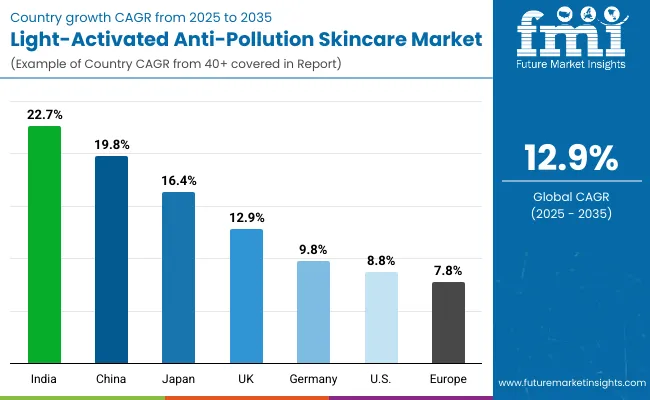
| Countries | CAGR |
|---|---|
| China | 19.8% |
| USA | 8.8% |
| India | 22.7% |
| UK | 12.9% |
| Germany | 9.8% |
| Japan | 16.4% |
The global light-activated anti-pollution skincare market demonstrates considerable variation across leading countries, with growth trajectories shaped by urbanization intensity, digital lifestyle patterns, and the regulatory positioning of skincare innovations. China is forecasted to record a CAGR of 19.8% between 2025 and 2035, supported by rapid adoption of encapsulation and sustained-release technologies alongside strong consumer receptivity to multifunctional, premium skincare. India is expected to emerge as the fastest-growing country at a CAGR of 22.7%, as clean-label preferences converge with rising disposable incomes and growing awareness of digital light protection. Japan is projected to maintain a 16.4% CAGR, anchored by consumer demand for dermatologist-tested solutions and a cultural emphasis on skincare sophistication.
In Europe, the UK is anticipated to expand at a CAGR of 12.9%, reflecting the influence of clinical positioning and regulatory-driven trust in dermatological products. Germany, with a 9.8% CAGR, is expected to sustain growth through innovation in blue-light and infrared defense categories that resonate with health-conscious consumers. The USA is projected to grow more moderately at 8.8% CAGR, reflecting a mature skincare environment where clinical-grade and dermatologist-validated claims drive adoption. These dynamics collectively highlight how diverse consumer priorities and innovation pathways will define the global growth outlook.
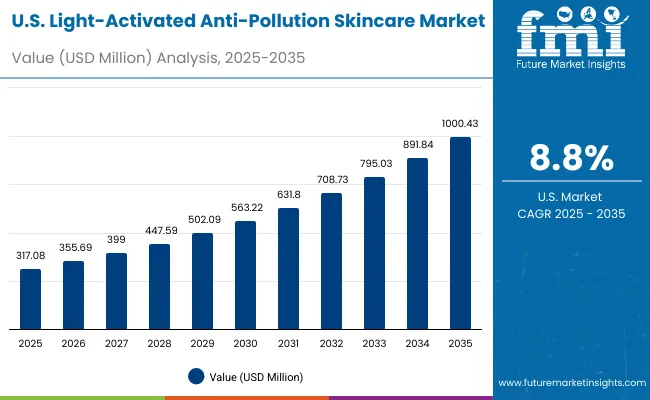
| Year | USA Light-Activated Anti-Pollution Skincare Market (USD Million) |
|---|---|
| 2025 | 317.08 |
| 2026 | 355.69 |
| 2027 | 399.00 |
| 2028 | 447.59 |
| 2029 | 502.09 |
| 2030 | 563.22 |
| 2031 | 631.80 |
| 2032 | 708.73 |
| 2033 | 795.03 |
| 2034 | 891.84 |
| 2035 | 1,000.43 |
The Light-Activated Anti-Pollution Skincare Market in the United States is projected to grow at a CAGR of ~12%, supported by rising demand for clinically validated, dermatologist-tested, and multifunctional skincare solutions. Consumer awareness of UV and digital light exposure has been strengthening adoption, while premiumization trends continue to shape purchasing behavior. The clinical-grade segment has been gaining prominence as trust in science-backed efficacy drives product preference.
Digital-first platforms have been expanding distribution, allowing wider consumer access and fostering direct engagement. Integration of skincare into broader wellness narratives, including digital protection and sustainability, is expected to further enhance penetration. Growth momentum is anticipated to intensify as e-commerce ecosystems expand and personalized skincare offerings gain traction among younger demographics.
The Light-Activated Anti-Pollution Skincare Market in the United Kingdom is projected to grow at a CAGR of 12.9% from 2025 to 2035, supported by rising awareness of digital light exposure and strict regulatory standards for dermatological products. Demand is anticipated to be shaped by trust in clinical validation and dermatologist-tested claims, with consumers seeking high-efficacy solutions backed by proven research. Premium skincare formats are expected to perform strongly as sustainability narratives resonate with eco-conscious buyers. Expansion is forecasted to be accelerated by the integration of clean-label positioning and transparent ingredient sourcing, further reinforcing consumer loyalty. E-commerce adoption is projected to support growth, particularly in reaching digitally active demographics across metropolitan regions.
The Light-Activated Anti-Pollution Skincare Market in India is forecasted to grow at a CAGR of 22.7% between 2025 and 2035, making it the fastest-growing country globally. Market expansion is expected to be driven by rising disposable incomes, greater consumer exposure to digital lifestyles, and demand for multifunctional skincare solutions. Clean-label and natural formulations are projected to resonate strongly, as traditional wellness practices combine with modern science to create unique consumer appeal. E-commerce ecosystems are anticipated to provide significant momentum, as digital-first platforms penetrate both urban and semi-urban areas. Increasing awareness of blue-light protection is forecasted to reinforce demand among younger demographics, who are highly active on digital devices.
The Light-Activated Anti-Pollution Skincare Market in China is projected to expand at a CAGR of 19.8% from 2025 to 2035, fueled by urban pollution challenges and increasing demand for premium skincare technologies. Encapsulation and sustained-release functions are expected to anchor performance, as Chinese consumers increasingly prioritize innovation-driven efficacy. Market growth is anticipated to be amplified by rapid adoption of digital-first retail channels, where influencer-led education fosters awareness and trust. Clean-label and multifunctional claims are projected to be strong differentiators, particularly as regulatory oversight ensures transparency and quality. Consumer loyalty is forecasted to be shaped by advanced formulations that combine blue-light defense with long-lasting anti-pollution protection.
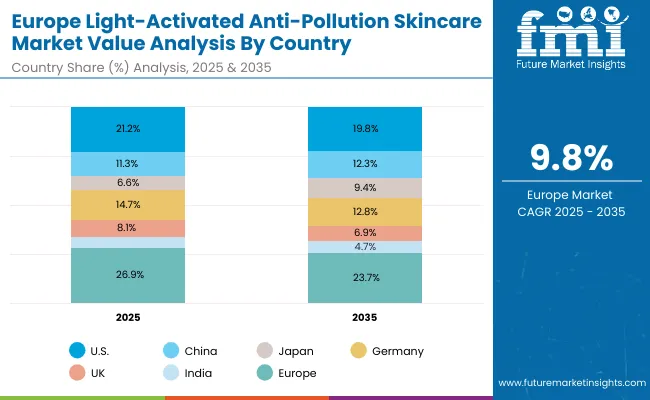
| Countries | 2025 |
|---|---|
| USA | 21.2% |
| China | 11.3% |
| Japan | 6.6% |
| Germany | 14.7% |
| UK | 8.1% |
| India | 5.0% |
| Countries | 2035 |
|---|---|
| USA | 19.8% |
| China | 12.3% |
| Japan | 9.4% |
| Germany | 12.8% |
| UK | 6.9% |
| India | 5.6% |
The Light-Activated Anti-Pollution Skincare Market in Germany is expected to grow at a CAGR of 9.8% from 2025 to 2035, reflecting steady adoption driven by regulatory trust and preference for dermatologist-tested solutions. Consumers are anticipated to prioritize blue-light and infrared defense, aligning with increasing awareness of digital and environmental skin stressors. Growth is forecasted to be concentrated in premium and clinical-grade segments, where efficacy and scientific validation serve as critical decision factors. Distribution expansion through pharmacies and specialist retailers is projected to maintain credibility while e-commerce channels enhance reach among younger demographics. Sustainability narratives are expected to hold significant weight, as German consumers remain focused on ethical sourcing and eco-friendly packaging.
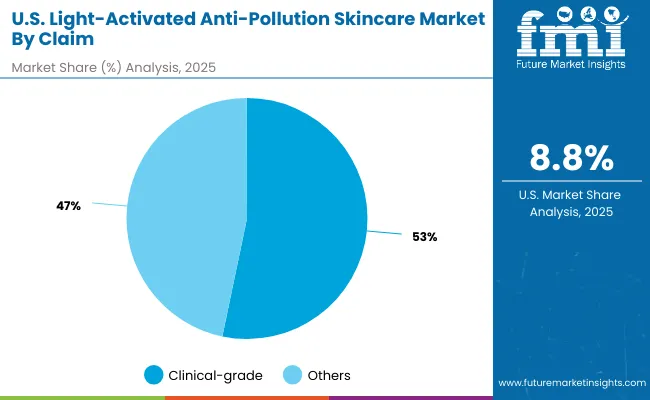
| Segment | Market Value Share, 2025 |
|---|---|
| Clinical-grade | 53.3% |
| Others | 46.7% |
The Light-Activated Anti-Pollution Skincare Market in the United States is projected at USD 317.08 million in 2025. Clinical-grade claims contribute 53.3%, equal to USD 169.1 million, while other claims account for 46.7%, valued at USD 147.97 million. This slight clinical-grade dominance reflects a strong preference for dermatologist-tested and science-backed skincare positioned around proven efficacy. Adoption is anticipated to be further reinforced by the USA consumer inclination toward formulations validated through clinical studies, which elevate trust and encourage repeat purchases. Other claims, however, are expected to maintain resilience, as clean-label, sustainable, and multifunctional offerings gain momentum with younger and wellness-oriented demographics.
The competitive trajectory is forecasted to be defined by the balance between clinically endorsed efficacy and consumer-driven demand for transparency. Integration of digital protection, sustainability claims, and advanced delivery mechanisms is projected to amplify the relevance of both categories, ensuring a diversified growth outlook for the decade.
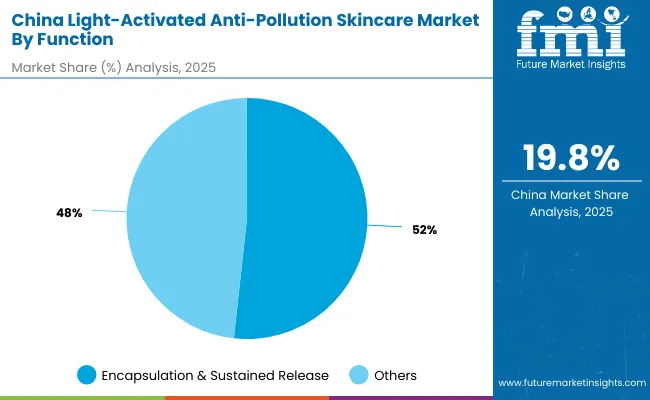
| Segment | Market Value Share, 2025 |
|---|---|
| Encapsulation & sustained release | 51.5% |
| Others | 48.5% |
The Light-Activated Anti-Pollution Skincare Market in China is projected at USD 164.12 million in 2025. Encapsulation and sustained-release functions contribute 51.5%, equal to USD 84.5 million, while other functions account for 48.5%, valued at USD 79.57 million. This marginal dominance of encapsulation-based systems highlights consumer preference for advanced technologies that ensure prolonged efficacy and deeper skin protection. Growth in this segment is expected to be reinforced by strong scientific validation, which aligns well with China’s evolving regulatory landscape that prioritizes safety and transparency. Other functions, including standard anti-pollution and blue-light defense, are anticipated to remain important, supported by urban pollution challenges and increased screen exposure.
The market outlook is projected to be shaped by the convergence of technology, science, and consumer demand for multifunctional solutions. Innovation in delivery mechanisms and cross-category integration with wellness products is expected to enhance adoption across urban consumer groups.
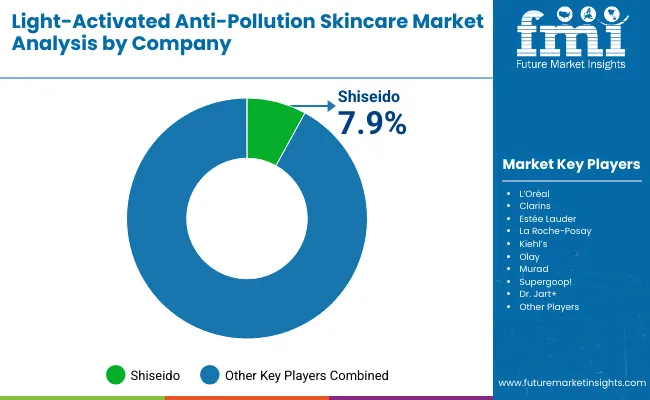
The Light-Activated Anti-Pollution Skincare Market is moderately fragmented, with global beauty leaders, established premium skincare brands, and emerging niche players competing across multiple segments. Shiseido has been identified as the leading player, holding 7.9% of the global market share in 2025, while the rest of the market remains divided among competitors such as L’Oréal, Estée Lauder, Clarins, La Roche-Posay, Kiehl’s, Olay, Murad, Supergoop!, and Dr. Jart+. The competitive advantage of Shiseido is expected to be reinforced by its innovation in light-activated complexes and its strong presence in East Asia, where consumer adoption of anti-pollution skincare is accelerating.
Other multinational brands, including L’Oréal and Estée Lauder, are projected to strengthen their positions by leveraging broad distribution networks and emphasizing multifunctional, dermatologist-tested solutions. Specialized players such as La Roche-Posay and Supergoop! are anticipated to expand rapidly in niche areas like blue-light protection and clinical-grade SPF solutions, appealing strongly to digitally active consumers.
Differentiation in this market is expected to shift away from traditional product lines toward innovation in encapsulation technologies, sustainability-led formulations, and digital-first engagement strategies. Competitive strategies are projected to revolve around clinical validation, clean-label positioning, and personalization, ensuring that global leaders and niche innovators align with evolving consumer expectations.
Key Developments in Light-Activated Anti-Pollution Skincare Market
| Item | Value |
|---|---|
| Quantitative Units | USD million;% share; CAGR |
| Market Size & Outlook | USD 1,452.4 million (2025); USD 4,902.6 million (2035); CAGR 12.9% (2025-2035) |
| Component/Claim | SPF-included; Clean-label; Dermatologist-tested; Blue-light protection; Others |
| Function | Anti-pollution shield; Blue-light/IR defense; Detox & decongestion; Repair & barrier support |
| Product Type | Moisturizers with SPF; Serums; Mists/essences; Primers; Others |
| Distribution Channels | Pharmacies; E-commerce; Premium beauty retail; Dermatology clinics |
| Regions Covered | North America; Europe; East Asia; South Asia & Pacific; Latin America; Middle East & Africa |
| Countries Covered | United States; Canada; Germany; France; United Kingdom; China; Japan; India; Brazil; South Africa |
| Key Companies Profiled | Shiseido; L’Oréal; Estée Lauder; La Roche-Posay; Kiehl’s; Olay; Murad; Supergoop!; Dr. Jart+ |
| Additional Attributes | Dollar sales by claim, function, product type, and channel; Encapsulation & sustained-release innovation; Clinical-grade and SPF-included leadership; Blue-light/IR defense adoption; Clean-label & dermatologist-tested positioning; E-commerce scale-up; Country growth leaders: India (CAGR 22.7%), China (CAGR 19.8%), Japan (CAGR 16.4%), UK (CAGR 12.9%), Germany (CAGR 9.8%), USA (CAGR 8.8%) |
The global Light-Activated Anti-Pollution Skincare Market is estimated to be valued at USD 1,452.4 million in 2025.
The market size for the Light-Activated Anti-Pollution Skincare Market is projected to reach USD 4,902.6 million by 2035.
The Light-Activated Anti-Pollution Skincare Market is expected to grow at a CAGR of 12.9% between 2025 and 2035.
The key product types in the Light-Activated Anti-Pollution Skincare Market are moisturizers with SPF, serums, mists/essences, and primers.
In terms of function, the anti-pollution shield segment is projected to command 55% share in the Light-Activated Anti-Pollution Skincare Market in 2025.






Full Research Suite comprises of:
Market outlook & trends analysis
Interviews & case studies
Strategic recommendations
Vendor profiles & capabilities analysis
5-year forecasts
8 regions and 60+ country-level data splits
Market segment data splits
12 months of continuous data updates
DELIVERED AS:
PDF EXCEL ONLINE
Skincare Supplement Market Size and Share Forecast Outlook 2025 to 2035
Skincare Oil Market Size and Share Forecast Outlook 2025 to 2035
Skincare Nutritional Serum Market Size and Share Forecast Outlook 2025 to 2035
Skincare Products Market Size and Share Forecast Outlook 2025 to 2035
Skincare Market Analysis - Size, Share, and Forecast Outlook 2025 to 2035
Skincare Packaging Market Size, Share & Forecast 2025 to 2035
Skincare Industry in India – Trends & Growth Forecast 2024-2034
Global Skincare Treatment Market Analysis – Size, Share & Forecast 2024-2034
Global PDRN Skincare Market Size and Share Forecast Outlook 2025 to 2035
Men’s Skincare Products Market Size, Growth, and Forecast for 2025 to 2035
Global Smart Skincare Market Size and Share Forecast Outlook 2025 to 2035
Cooling Skincare Gels Market Size and Share Forecast Outlook 2025 to 2035
Natural Skincare Preservatives Market Analysis - Size and Share Forecast Outlook 2025 to 2035
Ormedic Skincare Market Demand & Insights 2024-2034
Ceramide Skincare Market Size and Share Forecast Outlook 2025 to 2035
BPA-Free Skincare Market Trends – Demand & Forecast 2024-2034
Camellia Skincare & Cosmetics Market
Buffering Skincare Products Market Analysis - Size and Share Forecast Outlook 2025 to 2035
Menopause Skincare Solutions Market Size and Share Forecast Outlook 2025 to 2035
Probiotic Skincare Ingredients Market Size and Share Forecast Outlook 2025 to 2035

Thank you!
You will receive an email from our Business Development Manager. Please be sure to check your SPAM/JUNK folder too.
Chat With
MaRIA